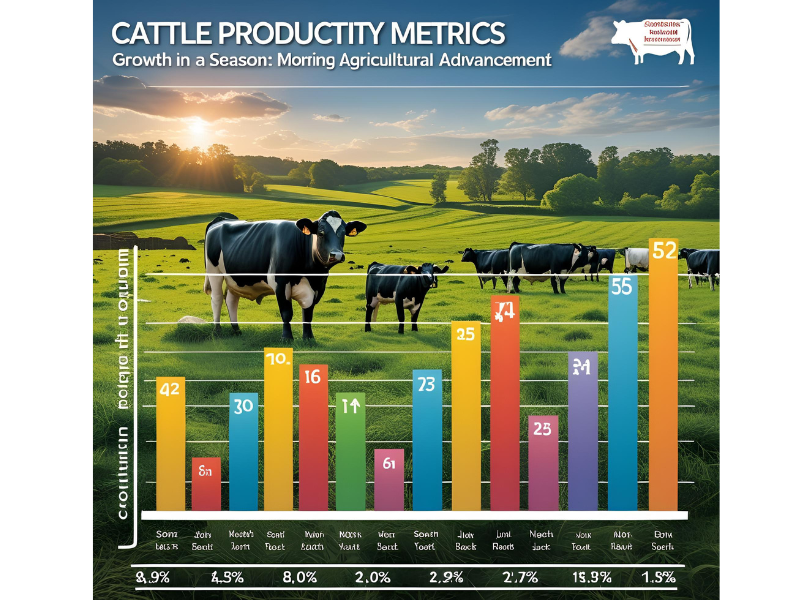In the world of dairy and livestock farming, the productivity of cattle directly impacts the income and livelihood of farmers. Higher milk yield, better growth rate, and improved reproductive efficiency are crucial indicators of productive cattle. But how can farmers increase cattle productivity while ensuring animal health and welfare?

In this blog, we will explore practical and proven tips to improve the productivity of cattle, especially relevant for Indian farmers and rural livestock keepers.
1. Provide Balanced Nutrition
Nutrition is the foundation of productivity. Without the right feed, even genetically superior cattle cannot perform well.
Key Tips:
- Green Fodder + Dry Fodder + Concentrates: Give a balanced mix of green fodder (e.g., maize, napier grass), dry fodder (e.g., wheat straw), and concentrate (grain + mineral mixture e.g.,GDP Powder).
- Protein-Rich Feed: Include oil cakes, bran, or specially formulated cattle feed to improve milk yield[e.g.,TOTAL-100 Liquid].
- Mineral Mixtures: Always mix mineral mixture in daily feed to prevent deficiencies[e.g.,GDP Podwer]. It improves fertility, milk production, and disease resistance.
- Clean Water: Provide 50-70 liters of clean drinking water per cow per day. Hydration affects milk production.
2. Focus on Breed Selection
Choosing the right breed is crucial for productivity. Indigenous breeds like Sahiwal, Gir, and Red Sindhi are known for their disease resistance and good milk yield in Indian conditions. Crossbred cows (like HF or Jersey crosses) produce more milk but require better care.
What to Look For:
- High-yielding cows with proven records.
- Disease-resistant breeds suited to local climate.
- Avoid inbreeding; choose bulls from different bloodlines.
3. Regular Health Check-ups and Vaccination
A healthy cow is a productive cow. Disease can drastically reduce milk output, fertility, and growth.
Preventive Measures:
- Vaccinate regularly for diseases like FMD (Foot and Mouth Disease), HS (Hemorrhagic Septicemia), and BQ (Black Quarter).
- Deworming every 3–6 months to avoid internal parasites.
- Routine veterinary visits to monitor health, especially during lactation and pregnancy.
4. Maintain Proper Housing and Cleanliness
Stress-free and hygienic housing directly affects milk output and growth.
Ideal Cattle Shed Conditions:
- Proper ventilation and protection from heat, rain, and cold.
- Non-slippery flooring to avoid injuries.
- Clean and dry bedding using straw or sawdust.
- Regular cleaning of dung and urine to avoid flies and infections.
5. Adopt Scientific Milking Practices
Improper milking can lead to mastitis (udder infection), pain, and reduced milk yield.
Best Milking Practices:
- Wash udder and hands before milking.
- Milk at the same time every day.
- Use full hand milking technique, not thumb-finger pinching.
- Ensure complete milking to avoid milk retention and infection.
6. Reproductive Management
A major reason for reduced productivity is poor reproductive performance.
Tips to Improve:
- Detect heat signs early and inseminate within the right window (12-18 hours after signs).
- Maintain calving interval of around 12-14 months.
- Give cows a rest period (dry period) of 60 days before the next calving.
- Consult a vet if conception does not occur within 2-3 cycles.
7. Use Technology and Record Keeping
Record keeping helps monitor productivity and plan improvements.
What to Record:
- Daily milk yield of each cow
- Vaccination and deworming schedule
- Breeding and calving dates
- Feed type and quantity given
Mobile apps and dairy management software can simplify these records.
8. Encourage Natural Behavior and Reduce Stress
Cattle are social and sensitive animals. Stress reduces productivity.
Reduce Stress By:
- Allowing cows to roam and rest freely when possible.
- Avoiding loud noises and sudden movements.
- Handling them gently, especially during milking and vet checks.
9. Train and Educate Farm Workers
Many losses happen due to poor handling or lack of knowledge.
Actions:
- Train workers in milking, feeding, and disease detection.
- Conduct regular awareness camps with veterinary professionals.
- Encourage participation in dairy development programs.
10. Use Supplements and Herbal Boosters
Sometimes natural feeding alone may not meet all the needs.
Useful Supplements:
- Calcium & Phosphorus: Especially in lactating cows[e.g.,CALBOL Liquid].
- Bypass fat: Improves milk fat percentage and energy levels[e.g.,GDP Powder].
- Probiotics: Improve digestion and feed efficiency[e.g.,BHOOKH NATH Pauch].
- Herbal tonics: Boost immunity and overall health[e.g.,TOTAL-100 Liquid].
Always use veterinary-approved products and follow dosage recommendations.
11. Improve Calf Rearing Practices
Today’s calves are tomorrow’s productive cattle.
What to Do:
- Provide colostrum within 2 hours of birth.
- Give nutritious calf starter feed from 2nd week.
- Deworm and vaccinate on schedule.
- Keep calves in clean, dry, and warm environments.
12. Control Heat Stress (Especially in Summer)
In India, extreme heat reduces appetite, milk yield, and fertility.
How to Manage:
- Provide shade and fans/sprinklers in the shed.
- Offer electrolyte-mixed water.
- Feed during cooler parts of the day (morning/evening).
Conclusion
Improving cattle productivity is not just about increasing milk yield. It’s a complete approach combining good nutrition, health care, housing, and management practices. When farmers focus on preventive care, scientific feeding, and good breeding practices, the results are clear—healthier animals, more milk, better profits.
By applying the tips shared in this blog, every farmer can take their dairy business to the next level.
🔔 Bonus Tip for Farmers:
Join Our WhatsApp groups, YouTube channels (like Tips Dairy with Vikasdeep), and Krishi Vigyan Kendras to stay updated on latest practices and government schemes.
